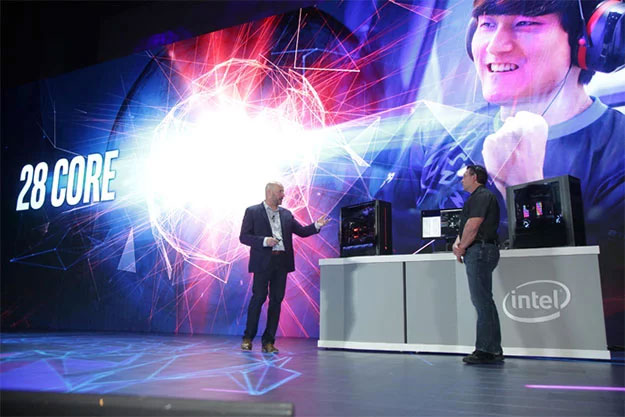Here’s What You Should Know About Intel's 28-Core 5GHz Computex Demo

Intel made waves at Computex this week when it trotted out a single-socket, 28-core processor and demonstrated the beastly chip running through Cinebench R15 and posting a score north of 7,300 points. It was quite the impressive demo, and of course the prospect of a consumer chip with 28 cores and 56 threads is certainly exciting, bolstered by Intel pointing out it was running at a lofty 5GHz. Pretty amazing, right? Well sure, but we've since learned some interesting tidbits about the mystery consumer chip that has tempered (though not completely dissipated) our enthusiasm.
For the demo, Intel used an existing 28-core Xeon processor based on the company's Skylake-X architecture. It's the same core used in the Xeon Platinum 8176, which is also a 28-core/56-thread processor, but clocked at only 2.1GHz (base) to 3.8GHz (boost) with 38.5MB of L3 cache and a 165W TDP. That part has an MSRP of about $8,700, though a consumer variant would undoubtedly cost less.

Image Source: Tom's Hardware
So, how did Intel get from a high of 3.8GHz on its Xeon Platinum 8176 to 5GHz on the chip it showed off at Computex? With some very fancy cooling, that's how.
There were two demo systems running the 28-core CPU at Computex, one from Asus and another from Gigabyte. Both consisted of a socket LGA3647 motherboard, the same 3,647-pin enterprise socket for Xeon chips. Apparently Intel made quick work of plucking its CPUs from those systems after the demo, and as the rigs were being hauled away from the show floor, it was observed that Intel was using an industrial water chiller to keep things cool. It's been identified as a Hailea HC-1000B, a water chiller that can move up to 4,000 liters per hour and uses R124 refrigerant to keep the water at a chilly 4 degrees Celsius.So Intel swiftly came in this morning and removed the 28 core CPUs from both ASUS and GIGABYTE's systems. It sounded like they gave the companies 20 minutes to hand over the parts
— Ian Cutress (@IanCutress) June 6, 2018
That is the kind of cooling that's necessary to run one of these monstrous chips at 5GHz. Whether the consumer version that Intel is planning to release can hit that kind of boost clock without extreme cooling remains to be seen, but what we saw wasn't that.
On the topic of power consumption, the prevailing opinion is that running a 28-core/56-thread chip at 5GHz (or thereabouts) will require a massive increase in power. That could very well be the case, though it may not be a massive jump from today's flagship from Intel. Leading up to the Core i9-7980XE reviews, many people thought power was going to be insane, considering the 10-core Core i9-7900X's power consumption. All things being equal, Intel was bolting eight more cores onto the Core i9-7980XE, which in theory could have pushed power consumption up by 80 percent. However, things didn't turn out that way.
So what does it all mean? We see three possibilities:
- Intel is going to use existing 28-core Skylake-X dies, tweak the power profile and boost clocks, and either bundle or require exotic cooling and power supplies.
- Intel has a new stepping of an existing 28-core design, perhaps using a tweaked manufacturing process, that it’s going to package up for the consumer market with an aggressive power profile to ensure it can boost to 5GHz. Or...
- Intel has a new chip, perhaps Cascade Lake-X that it’s confident will do what they showed on stage, so they made a public proclamation of a 28-core / 5GHz chip.
And yes, all of that is speculation because Intel didn't officially offer any information on how it will achieve what the company demonstrated.
It's going to be an exciting year with Intel and AMD battling in the high-end desktop (HEDT) arena. Things are already heating up—following Intel's 28-core demo, AMD announced a 32-core/64-thread second generation Ryzen Threadripper processor, and in the process practically ensured that it will continue to wear the multi-core crown in the consumer sector. Not to mention, AMD's demo was on an existing consumer chip that will ship in its current form, or very close to it, in Q3 this year, along with the fact that cooling for it can be accomplished on air. That's a stark contrast right there.
This is the Threadripper 2's cooler, keep in mind that it can still be air-cooled which is impressive on its own. I'd probably recommend water cooling it though. Like with the full cover TR4 block and 360mm radiator. iPhone X for reference and @cavemanjim too. pic.twitter.com/jYCTSOEnec
— Anshel Sag (@anshelsag) June 6, 2018
As for Intel, it remains to be seen what its 28-core chip will be capable of. That said, we wish it would have been upfront about the cooling, clock speeds, and the platform at play. The demo was a bit misleading in our opinion, but as always, we'll reserve final judgement for when the product actually ships and we have a chance to spend some hands on time with it, whatever it ends up being.

